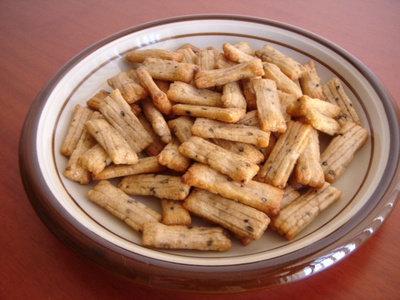It was around 30 years ago when my husband and I unexpectedly moved to Brazil for his new job assignment. Unlike today, soccer wasn’t as popular of a sport in Japan back then, and there was little to no information about Brazil that was available in Japan. I myself could only identify Brazil as a country of coffee and carnivals—at the time, I even thought the carnival was a daily occurrence over there—so I still remember as if it were yesterday about how anxious I felt before moving to Brazil.
Back then, there were restrictions on the import of Japanese goods in Brazil, so it was difficult to find any Japanese food. The senbei (Japanese crackers) that I secretly brought in my suitcase became something that I treasured.
When I introduced myself to a fellow Japanese neighbor in the same apartment, she handed me some Brazilian okaki (rice crackers) and said, “It might not taste good to you right now since you just got here, but you’ll start to like it after you live here for about 4-5 years.”
Indeed, having just arrived from Japan, I could hardly say that it tasted good at the time. Once I depleted my personal stash from Japan, I had an intense craving for some senbei so I set out to Liberdade (São Paulo’s equivalent of Japantown). I had hoped to find the circular shoyu senbei, but all that was available was the okaki. The Brazilian okaki definitely tasted different from okaki made in Japan. The cracker was tough and it lacked flavor. One good thing about it was that it didn’t become stale too easily, even if I forgot to store them properly. Perhaps it was due to the dryness of the air in São Paulo.
Interestingly, or perhaps inevitably, by the time we were to return to Japan after 5 years in Brazil, I found myself regularly eating the Brazilian okaki, just as if it were my favorite “Japanese okaki” that I grew up with. I had grown to like the Brazilian okaki.
Another thing that had left a strong impression on me was the Brazilian “Umeboshi” (pickled plums). Its appearance was nothing close to an actual umeboshi made from ume plums, but the salty-sour flavor was definitely there, making it a worthy substitute for umeboshi. I bought it for the first time when I saw the homemade product being sold at the feira (morning market). I clearly remember its unique shape, but had always wondered what exactly it was made from.
I recently asked about the “Brazilian umeboshi” to an older Nisei person who came to visit Japan. This person explained that the “Brazilian umeboshi” was only available seasonally, and are typically sold at the feira in May or June. I was surprised to learn that they were made from the sepals of a flower. Apparently, it comes from a flower called the Roselle, which is a type of Hibiscus under the plant family Malvaceae. I thought about the immigrants eating their homemade umeboshi, yearning to replicate the familiar flavor of the Japanese umeboshi and dreaming of one day returning home to Japan. It really hits home to think about the amount of effort and creativity they put into producing their own version of umeboshi.
Today, there are no import restrictions on goods, so umeboshi made in Japan as well as traditional-style umeboshi made from Brazilian ume plums can be found at the Japanese grocery markets in Brazil. Only a select few seem to even know about the existence of the old “Brazilian umeboshi”.
I once discovered the recipe for it on the Internet. Removing the seeds from the sepals of the Roselle seemed like a tedious task, but the recipe itself using vinegar, salt, and sugar was quite simple—only taking about 24 hours for completion. On the other hand, in Japan it proved to be very difficult to find Roselle sepals for consumption. Perhaps that “umeboshi” should be called the “Phantom Umeboshi” which can only be found within the Nikkei community in Brazil.
Just as I was thinking that I’d like to have it again, a friend from Brazil sent me this photo!!
That “Phantom Umeboshi” had become commercialized as a product called “HANA UME (Flower Ume)”!! I’m so happy to hear that I might be able to get the “Phantom Umeboshi” without having to go to the feira in May or June. Now, more than ever, I can’t wait to eat it again.
© 2012 Naomi Kimura






